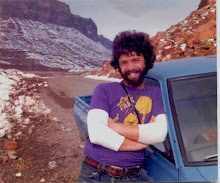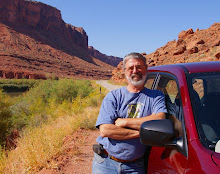 April is a hard edged month on the Colorado Plateau, blowing in from the west just behind spring’s equinox. After a high desert winter with the usual spate of below zero nights and grimy inversion layers in the valley, March regales us with longer days and brighter hopes. In anticipation of irrigation, the neighbors gather with shovel and barrow for local ditch cleaning parties. Freed from their burden of silt and debris, the cleared canals await the arrival of that first flush of thick water from the Colorado River. Out in the gardens sprinklers are checked and hoses reinstated. Barbecue grills are rolled out. Henleys are traded in for T-shirts. Garage sale ads abound. And trailhead parking lots are filled with optimistic hikers and bikers.
April is a hard edged month on the Colorado Plateau, blowing in from the west just behind spring’s equinox. After a high desert winter with the usual spate of below zero nights and grimy inversion layers in the valley, March regales us with longer days and brighter hopes. In anticipation of irrigation, the neighbors gather with shovel and barrow for local ditch cleaning parties. Freed from their burden of silt and debris, the cleared canals await the arrival of that first flush of thick water from the Colorado River. Out in the gardens sprinklers are checked and hoses reinstated. Barbecue grills are rolled out. Henleys are traded in for T-shirts. Garage sale ads abound. And trailhead parking lots are filled with optimistic hikers and bikers.But before too long, the lion of early April nips at the heels of late March’s lamb. Buffeting winds blow elm seeds into drifts along city streets. The cut-off lows sneak in from the Pacific with surprising swiftness and sometimes snow. Or one last pulse of polar air pushes down from the north wreaking havoc on the apricot and peach orchards. And we dare not hike without “layering”. Heavy shirts at the outset. Maybe parkas. Stripped down to tees as soon as the sun breaks through. Then back to fleece and flannel when the sudden snow flurry blows through. And maybe back to short sleeves before we get back to the car.
This then is the enigma of spring in the canyon country. The red earth is not quite ready to relax. The sky is still an unsettled miasma of ragged clouds. And the incessant wind further shapes the sandstone, piling up little dunes along the base of cliffs and flinging grains of sand at the unsuspecting and unprepared. Nature does her spring cleaning in a fast and fickle manner, trimming dead branches from the cottonwoods, distributing seeds and pollen, and sending errant tumbleweeds rolling across the open range.
But those of us who live here know what is coming. We can see it in the early blooming twin pod and loco weed, in the first appearance of butterfly and lizard. And in the slow rising of the Colorado River from the melting snow upstream. Soon the covers will come off of the swamp coolers. Cactus flowers will bloom. The green on Grand Mesa will overtake the white. And the rock will radiate that dry, dense heat that I can wrap myself into like a child.




Greg, your language paints a lovely picture!
ReplyDeleteYes it does!
Delete